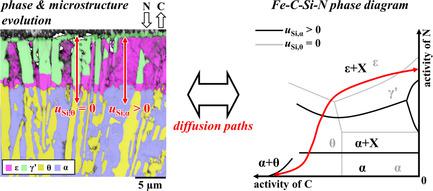当前位置:
X-MOL 学术
›
Adv. Eng. Mater.
›
论文详情
Our official English website, www.x-mol.net, welcomes your feedback! (Note: you will need to create a separate account there.)
Nitriding of White-Solidified Fe–C–Si Alloys: Diffusion Path Concept Applied to Inhomogeneous Microstructures
Advanced Engineering Materials ( IF 3.6 ) Pub Date : 2021-09-03 , DOI: 10.1002/adem.202100833 Stefan Kante 1 , Mykhaylo Motylenko 1 , Andreas Leineweber 1
Advanced Engineering Materials ( IF 3.6 ) Pub Date : 2021-09-03 , DOI: 10.1002/adem.202100833 Stefan Kante 1 , Mykhaylo Motylenko 1 , Andreas Leineweber 1
Affiliation

|
The microstructure formation during nitriding of white-solidified Fe–C–Si alloys, relevant to advanced surface treatments for cast irons, is studied. The as-cast microstructures mainly contain Si-free, C-rich eutectic cementite and Si-enriched, C-lean ferrite/pearlite. The spatial extent of these microstructure regions is significantly larger than the diffusion distance of Si during nitriding. The phases and microstructure forming during nitriding vary with the local Si content in the substrate. Nitriding conditions only allowing to form γ′–Fe4N from pure α-Fe generate a compound layer composed of γ′–Fe4(C, N), ε–Fe3(C, N)1+x
, and Si-rich nitride, X. ε is the main constituent, whereas γ′ only forms from Si-free eutectic cementite. Different nitriding experiments elucidate the interrelated thermodynamic and kinetic effects of C and Si on the phase evolution and the compound layer growth. A schematic model of the microstructure evolution is developed. Information on the topology of the largely unknown Fe–C–Si–N phase diagram is derived from the experimental observations. For this, the diffusion path concept is adapted to describe the microstructure formation during nitriding of compositionally inhomogeneous alloys, in which substitutional alloying elements are heterogeneously distributed and largely immobile. α + ε and α + ε + X phase fields are identified as particular features of the Fe–C–Si–N phase diagram at 540 °C.
中文翻译:

白色凝固 Fe-C-Si 合金的氮化:应用于非均匀微观结构的扩散路径概念
研究了与铸铁先进表面处理相关的白色凝固 Fe-C-Si 合金氮化过程中的显微组织形成。铸态显微组织主要包含不含Si、富C的共晶渗碳体和富Si、贫C的铁素体/珠光体。这些微结构区域的空间范围明显大于氮化过程中Si的扩散距离。氮化过程中形成的相和微观结构随衬底中的局部 Si 含量而变化。仅允许从纯α-Fe形成γ′-Fe 4 N的氮化条件产生由γ′-Fe 4 (C, N)、ε-Fe 3 (C, N) 1+ x组成的化合物层 , 和富硅氮化物, X. ε 是主要成分, 而 γ' 仅由无硅共晶渗碳体形成。不同的氮化实验阐明了 C 和 Si 对相演变和化合物层生长的相互关联的热力学和动力学影响。开发了微观结构演变的示意图模型。关于很大程度上未知的 Fe-C-Si-N 相图的拓扑信息来自实验观察。为此,扩散路径概念适用于描述成分不均匀合金氮化过程中的微观结构形成,其中替代合金元素分布不均且基本固定。α + ε 和 α + ε + X 相场被确定为 540 °C 时 Fe-C-Si-N 相图的特殊特征。
更新日期:2021-09-03
中文翻译:

白色凝固 Fe-C-Si 合金的氮化:应用于非均匀微观结构的扩散路径概念
研究了与铸铁先进表面处理相关的白色凝固 Fe-C-Si 合金氮化过程中的显微组织形成。铸态显微组织主要包含不含Si、富C的共晶渗碳体和富Si、贫C的铁素体/珠光体。这些微结构区域的空间范围明显大于氮化过程中Si的扩散距离。氮化过程中形成的相和微观结构随衬底中的局部 Si 含量而变化。仅允许从纯α-Fe形成γ′-Fe 4 N的氮化条件产生由γ′-Fe 4 (C, N)、ε-Fe 3 (C, N) 1+ x组成的化合物层 , 和富硅氮化物, X. ε 是主要成分, 而 γ' 仅由无硅共晶渗碳体形成。不同的氮化实验阐明了 C 和 Si 对相演变和化合物层生长的相互关联的热力学和动力学影响。开发了微观结构演变的示意图模型。关于很大程度上未知的 Fe-C-Si-N 相图的拓扑信息来自实验观察。为此,扩散路径概念适用于描述成分不均匀合金氮化过程中的微观结构形成,其中替代合金元素分布不均且基本固定。α + ε 和 α + ε + X 相场被确定为 540 °C 时 Fe-C-Si-N 相图的特殊特征。



























 京公网安备 11010802027423号
京公网安备 11010802027423号